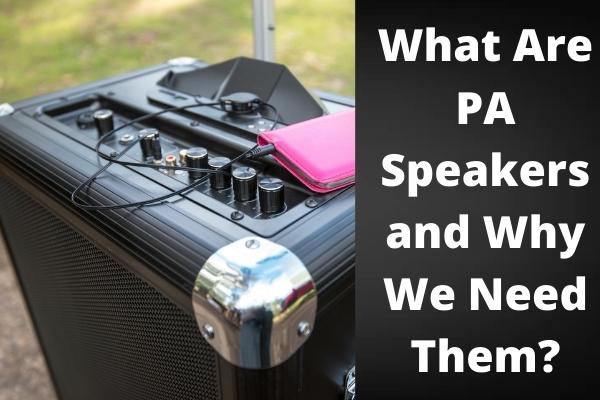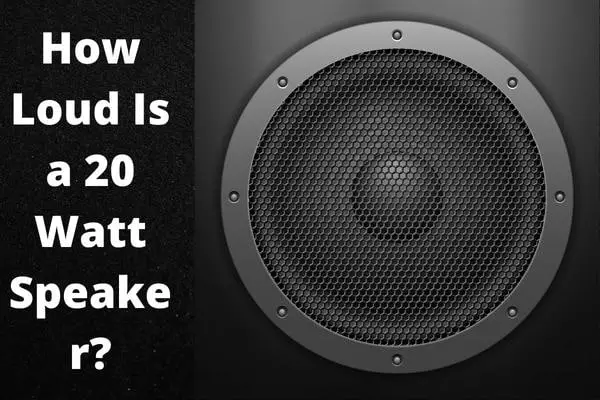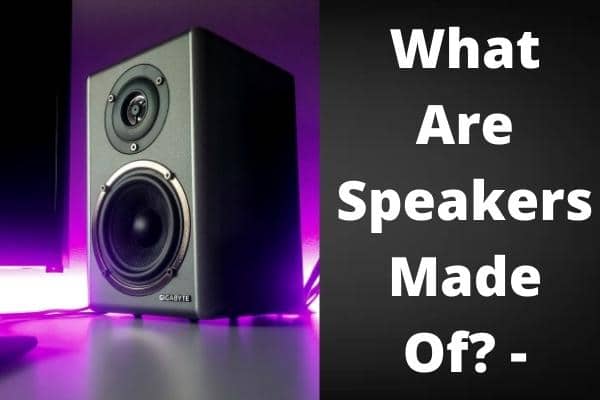
What are PA Speakers? This question was mostly asked by people unaware of the difference between indoor and outdoor speakers. Professionals use PA speakers for performing at a live outdoor concert or for a large group of people.
An essential part of your job as a performing artist is finding a live sound system that fits your style, your budget, and the places where you play. No matter where you perform — a cafe, bar, club, or even a wedding reception, you’ll need a PA system if you want to be heard.
When purchasing your first PA system or wanting to expand your current setup, this guide will take you through these and other essential aspects to help you discover the gear that’s best for you.
- What Is A PA System?
- Why We Need Them
- PA System Classification
- To Place A Public Address System, What Do I Need?
- 1. Speakers
- 2. Audio Mixer
- 3. Amplifiers
- 4. Speaker Processors
- With A PA System, What Other Accessories Do I Require To Operate?
- 1. Microphones
- 2. Cables
- 3. Speaker Stands
- Conclusion
- Frequently Asked Questions
What Is A PA System?
In simple words, PA systems are public address (PA) systems. It is also known as an audio reinforcement system, which brings sound from the artist to the audience. Even though each system differs substantially, the following essential functions are carried out by each one of its many parts:
- Using microphones or line inputs to convert acoustic sound into electrical signals.
- These electrical impulses are processed and mixed utilizing effects modules and mixing boards.
- Using a power amplifier to amplify signals.
- In-ear or speaker monitors are used to keep an eye on the performer.
- Sound is transmitted via speakers.
- Each PA equipment will have varied capabilities, features, and designs available for each purpose. What you need from each will be determined by your requirements.
Why We Need Them
Since the first hand-held megaphone cones were created, PA systems have evolved tremendously. Before, they were used to simplify and speed up public speaking. Still, today’s more complicated systems contain many microphones and speakers and mixing consoles and amplifiers to make music and human voice more audible at public events.
A PA system is likely to be required with any kind of large-scale event (concert, party, etc.). When it’s time to buy something, the problem emerges. PA speakers may range from a few hundred to a few thousand dollars in price and complexity. But the most significant difference between active and passive speakers is how they operate.
PA System Classification
It doesn’t matter whether you’re running a performance space or creating a mobile platform; you’ll always need a high-quality PA system that can satisfy your needs now and in the future. In terms of size, we may classify PA systems as personal PAs, medium PAs, or full-size PAs.
- Personal PA: When it comes to portable audio systems, the most common configuration is a single speaker or small sound system (like Bose L1 series) that may be utilized as a player’s main speaker or as an audio feedback device
- Medium PA: A primary wedge-shaped feedback sound device and a pair of vertical speakers on each side of the stage typically make up a medium PA.
- Full-Size PA: Multi-speaker line arrays and sophisticated monitoring systems are required for large-scale PA setups.
Most nightclubs, churches, and mobile DJ platforms use medium-to-high-end professional pa amplifier systems. A medium-sized PA power amplifier should be used if the crowd is modest.
Suppose the venue has a vast indoor capacity (more than 500 people). In that case, you’ll need a more powerful amplifier and larger speakers significantly. There are a plethora of approaches to creating high-quality loudspeaker equipment.
To Place A Public Address System, What Do I Need?
The components of a PA system, whether it’s for speech or music, include:
- Speakers – either active or passive
- Audio Mixer
- Amplifiers –only need if utilize passive speakers
- Speaker Processors
Public address system components are available in various forms and configurations. The speakers are the first thing we’ll look at, so let’s get started.
1. Speakers
When one thinks about public address systems, the first thing that comes to mind is the speakers, which are of prime significance. A wide variety of PA speakers may be found on the market.
Main speakers, sometimes known as “tops,” subwoofers, and stage monitors, are the three primary kinds of PA speakers. Each speaker performs a different purpose in the system, yet they all rely on each other.
Main Speakers (Tops)

For your main speakers, you’ll need to consider how loud they are, how wide their frequency response is, and how big and heavy they are, as well as the materials used to make them. When purchasing speakers, it’s essential to think about what you want to use them for. Speakers use vibration to move air.
You’ll need to know how far your sound can travel and what kind of place you’re in before you start recording. The PA’s sound is made up mostly of its main speakers.
Basic PA systems often use speaker stands or subwoofers installed on top of the speakers. Smaller tweeter speakers are often used to supplement the woofers in most basic PA systems, typically measuring between 10” and 15” in length.
Subwoofers

The enormous speakers used to reproduce the lowest bass frequencies are referred to as subwoofers. Because of their size and the danger of damage to other components posed by the intense vibrations they produce, they are not often utilized in full-range enclosures.
Adding a subwoofer to your PA will, of course, reduce its portability. A power amp capable of generating the watts needed by power-hungry subs is necessary unless you use a powered subwoofer. Subwoofers are most often used in heavy metal, reggae, hip-hop, and other genres that rely on strong bass and drum sounds.
Monitor
Having the ability to hear your voice while performing is essential. No matter what kind of instrument or voice you’re using, adequate monitoring is crucial to a successful performance. Wedges and sidefills are the two main kinds of stage monitors. An angled rear speaker cabinet called a wedge might be used on stage.
Their slanted design helps them to direct sound into the performer’s ears. But their low profile prevents them from doing so. A sidefills are enormous, full-range speakers that are positioned off to one side of the stage.
Individual mixes for each musician are provided via wedges that allow for a rough mix of the ensemble. When it comes to staging monitors, more significant isn’t always better. It’s a constant problem onstage, and bigger speakers exacerbate the situation since they create more bass.
A tighter coverage angle and more prominent upper midrange will help monitor speakers penetrate the dense sound onstage. As a result, it is preferable to have more concentrated stage wedges rather than fewer monitors with wider coverage and heavier bass.
An effective public address (PA) system must have high-quality speakers. Passive and active speakers are both possible for speakers. How do you interpret this? Passive or active speakers are among the first things to consider. It’s clear to observe that there are substantial differences:
Active Speakers
Speakers powered by the mains are those that have their own on/off switch, volume control, and other connection options on the speaker itself. When compared to traditional speakers, active speakers are simpler to set up and more versatile when it comes to connecting to a variety of devices.
Because each speaker has its plug point, they’re perfect for compact installations. They don’t need any additional power components or connections to be transported.
Passive Speakers
To produce sound, passive speakers must be powered externally. A power amplifier with numerous speaker outputs is often used to do this. For large systems or those that may need to grow in the future, passive speakers are preferable since they can all be powered by a limited number of power sources.
In addition to being lighter, the absence of built-in electronics makes them simpler to transport when purchased in large quantities.
2. Audio Mixer

The microphone signal is processed by a mixer, which then balances it to get the best possible sound quality. Many of the small mixer or portable PA system inputs are limited. But the inputs on a professional mixer are many. They may support a large number of microphones.
The sound may be shaped by manipulating the high, medium, and low frequencies. The goal of mixing in a band is to avoid the overall sound from becoming a jumbled mess by carefully shaping each instrument’s sound.
A digital mixer’s ability to remember pre-sets saves time on the day of a concert since you don’t have to spend time modifying mixes. Some simple effects and signal processing tools for your PA system include the following:
Compression And Limiting
As the name implies, compressors reduce the dynamic range of an audio stream by minimizing the difference of sound in a quiet and loud environment. It smooths out your sound and safeguards your gear by preventing clipping, which may ruin speakers if the amplifier is driven too hard into distortion.
Compressors that are well-designed minimize signal distortion and give your audio a satisfying amount of sustain. Like a compressor, a limiter reduces the volume of the music so that your speakers and hearing are not damaged.
The compression ratio may be relatively high when using a limiter, enabling compression to occur over a certain level. There will be no cutting or distortion because of this.
Reverb And Delay
Reverberation (from reverb) is a sound-richening effect that simulates object reflections. If you are a washroom singer, your voice sounds better in the shower because it has more depth and dimension than reverb. You create “space” and drama when you sing in front of hard, reflective surfaces; you create “space” and drama.
You may regulate these reflections using a reverb unit’s customizable settings, allowing you to replicate diverse acoustic conditions. For example, a delay may be defined as one or more echoes that are more clearly heard than normal echoes.
The initial sound becomes less audible in the long run since it is repeated more clearly (partial words, musical phrases, etc.). You’ll encounter delay if you yell into a deep canyon; the waves that return to you will become smaller and smaller as you keep shouting.
3. Amplifiers

Active or passive PA speakers are available. In contrast to passive speakers, which rely on an external amplifier to boost the mixer’s line-level signal to the speaker’s required level, active speakers have their own built-in amplifiers. Amplifiers might be pricey, but that’s because they’re well-made. Passive PA systems rely on a single component to provide the whole system’s audio.
4. Speaker Processors
A loudspeaker management system is an additional essential part of a PA system. Passive PA systems and powered speakers use signal processors termed PA management systems or speaker processors between the mixing console and the amplifiers.
One of its most significant functions serves as a crossover, dividing the entering signal into three bands: highs, mids, and lows. Passive PA systems benefit significantly from the signal routing capabilities of a speaker processor, which is especially handy when dealing with big multi-speaker setups.
Additionally, it safeguards your speakers from harm caused by unexpected feedback by giving you a great deal of control. Audio compression, limiter, and equalization are valuable tools included in a PA speaker management system (SMS).
With A PA System, What Other Accessories Do I Require To Operate?
When planning your next concert, it’s possible that you’ll need more PA system accessories.
1. Microphones

There are additional microphones needed if your PA has a lot of channels. Condenser and dynamic microphones both fall under the umbrella term “umbrella.” When using a condenser microphone, you’ll need phantom power.
To change the character and strength of your signal, you may utilize the mixer’s built-in phantom power and internal preamp. It is common for external preamps to give improved sound quality and reduced noise levels, and unique features. In terms of versatility, dynamic microphones are a great option.
This implies that they can record sound from all angles. When it comes to high-frequency instruments, condensers are the most precise. Because of this, they’re usually kept in the studio instead of using outdoors. For live performances, dynamic cardioid microphones are the ideal choice.
2. Cables

Different cabling is needed to link the various components of a PA system and deliver an audio signal. When putting up a PA, it is essential to use the right cabling. Cables and connections might malfunction if used incorrectly. When done poorly, utilizing the incorrect cables or connections may be dangerous.
You may require at least 40 feet of speaker wires, depending on how your PA is set up and the size of the venue. When connecting the outputs of a mixer to numerous crossovers, power amplifiers, and speakers, you’ll almost certainly need to use at least two distinct kinds of cable connectors.
Various cable connector types are available for audio equipment, and this guide will help you choose the right one.
TRS Connector
A “Tip-Ring-Sleeve” is referred to as “TRS.” Connectors with a balanced pinout of 1/4” (or 1/8”) are known by this designation. If you want to know what a TRS plug looks like, you can find one at the end of most headphone wires.
On the outside, it seems to be a conventional 1/4′′ plug with an additional “ring” on the shaft. When you require two conductors and a ground (shield) in one plug, TRS connections are the best choice.
TS Connector
An unbalanced, 2-conductor 1/4” connection is known as a “Tip-Sleeve.” The acronym “TS” refers to this particular design. Generally, the signal is applied to the “hot” tip. At the same time, the “ground” or “shield” is attached to the “sleeve.”
SpeakON
Speakers and amplifiers with high power ratings often use the speakON multi-pin connection type (and brand). The speakON connectors provide a substantial connection, carry a lot of power, and are very long-lasting.
Banana Connector
If you have a power amplifier with binding posts on the rear or a banana jack, you’ll want one of these banana plugs to connect your speakers. The binding post receptacles on the rear of power amps are typically placed 3/4′′ apart, which is the conventional layout of banana plugs.
XLR Connector
The XLR connection has three pins: a positive, a negative, and a ground. Typically, they provide balanced audio signals from microphones to mixers or audio signals from speakers to powered amplifiers.
3. Speaker Stands
Additionally, speaker stands or tripods might be a worthwhile purchase. More outstanding sound quality is achieved by placing speakers at a high altitude, which results in less feedback. The speaker stands that come with specific PA systems are very impressive.
Conclusion
PA speakers aren’t only outstanding for music; they’re also great for speaking and performing instruments. As a result, PA speakers are intended to provide the best quality, most powerful, clearest audio output.
Modern powered PA speakers are ideal for music playback since they are the right speaker for you and your specific playback needs.
Frequently Asked Questions
How Much Power Do I Require?
How much power you require depends on how loud your music is to be played. It’s a common misconception that the wattage of a wireless PA speaker is all that matters. The sound pressure level (SPL) better gauge a speaker’s capacity to produce volume than watts. Coverage angle is also critical.
Even a great speaker can only reach a smaller audience if their range is restricted. It’s also essential to think about how sensitive the speaker is. Sound is more effectively converted to sound when the speaker is more sensitive. In many cases, a 500-watt speaker with excellent efficiency outperforms a 1,000-watt competition in terms of sound quality and clarity.
Are PA Speakers Suitable/Good to Use At Home?
Even though PA speakers are not meant to be used as home audio speakers, you may utilize them as such without any problem. You can acquire good-sounding PA speakers for a fraction of the price you’d pay for a high-end home audio system.
It’s also a good idea if you often host parties at your home to have some PA speakers. However, you should know that PA speakers are pretty powerful and may grow extremely loud. They may be used at home only if the volume is reduced. Loudspeakers in the neighborhood are generally not something you’d want to do.
Are PA Speakers Designed Only For Speech?
Despite the widespread belief that PA speakers are exclusively for live events, they may be used for various purposes, including listening to music and podcasts. It’s a fact that these speakers can handle a broad range of sounds, and that’s why they’re so popular.
PA stands for Professional Audio. With the finest possible output clarity and a broad range of sound coverage, speakers in this class are among the best available. Additionally, PA speakers are adaptable and high-quality enough to perform effectively at any sound output.
It is common for PA speakers to be utilized as a part of a larger PA system, which implies that they perform best when combined with other speakers. If a PA speaker is designed to emit a specific range of frequencies exclusively, this is very important to remember.
It’s possible to construct certain PA speakers for mid and high frequencies, while others are built to produce bass frequencies.






